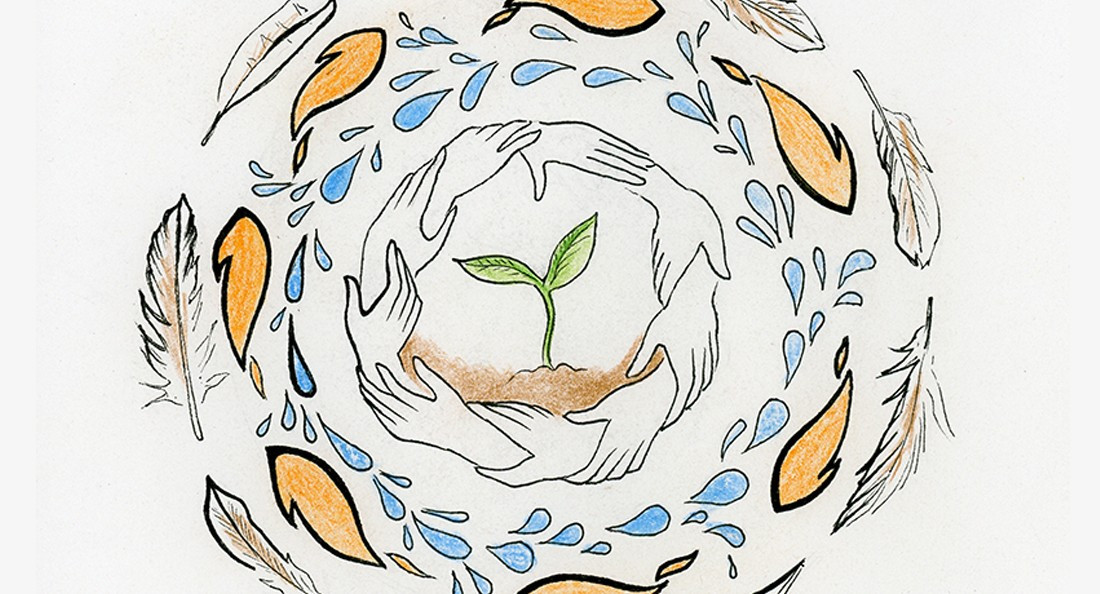Land, water and the health of the environment
Elders talk about Indigenous history
A thesis written by Natasha J. Szach argues that preserving water will give the Indigenous community a chance to move from being a stakeholder into a partner when governing the Canadian people.
Goals like this and others the Truth and Reconciliation Commission (TRC) align with the United Nations’ adopted goals to end poverty, conserve the environment and to guarantee the prosperity for all people, which were adopted in September of 2015.
“Just like everything else, the earth, the land and all the water is sacred, because it has to do with life. It’s life-giving, and it’s used for ceremonies … it’s one of the things used in our traditions,” Marlene Kayseas, an elder in residence at the University of Manitoba (U of M) says.
Kayseas, originally from Fishing Lake First Nation, Sask., found on Treaty Four land, explains that water is presented during ceremonies by women, because they are seen as nurturers who care for everything, just as the water does.
“Water is like a birth. When women have a baby, there’s a lot of water. Water is the most important thing in birth. Same thing with the earth. The water goes all over it, and that’s why it’s sacred, because it keeps everything alive,” she says.
She goes on to say that Indigenous culture has not come back from the damage that it has taken from residential schools, but now there are some goals that will provide guidance to Indigenous communities.
“There are so many talented Indigenous people in the communities, but they are drunks today. They don’t use their gifts because of what happened to us: being separated, being abused and all that. That’s the reason, and it affects everywhere and everything,” she says.
Kayseas brings up topics of Indigenous past as an objective to be spoken about in the community, so that members can remember the struggles and pain of their people.
During the First World War, thousands of Indigenous people voluntarily enlisted to support Canada in their efforts. Hundreds were injured or died, but some who returned home were awarded with medals.
However, many Indigenous veterans were subjected to the unequal treatment they faced prior to the war.
“When Indigenous people were sent to war, their families were really affected, because they lost some people. (The soldiers) couldn’t speak, and I know that’s a big part too,” she says.
She notes that she cannot feel a connection to the Creator, because the environment is no longer clean.
“Now Mother Earth is all full of garbage, and not even our prayers (can) really connect with ourselves in a good way, because there’s too much anger, garbage and confusion from what happened. We’re unable to connect with Creator. Before all this happened, we were able to pray and take care (of ourselves). Everything was in order, like a system,” she says.
Norman Meade, a Métis elder in residence at the U of M and a pastor who is originally from Manigotagan, Man., says it would be difficult for people to live off of the land now, because people would not know how to survive by just using environmental resources.
“The younger generations did not live the lifestyles of the older generations. If I had to go and live off the land again, I would find it difficult. One, because of my age, and also because it’s a lot more difficult to get things you would need,” he says.
He says when he was a child, people would take logs from the bush and build their own homes, to shelter themselves and their families. For food, people would not be able to hunt as freely as they used to, and there are not as many animals as there were before, but they can still grow a garden on their property.
“In the community, everybody looked after everybody. You looked after one another. The older people were not as able as the younger ones. Younger people looked after them. There was no place to put your mum or dad when they got old or got sick. Somebody had to look after them,” he says.
He goes on to say that this would be the same when dealing with children. He says that if a child lost their parents at a young age, other adults would care and raise the children without an adoption process, but out of a sense of duty.
He compares this to how a parentless child would be placed into Child and Family Services. He also says if a person’s house were to burn down, people from the community would help them build a new one. When it comes to the TRC’s goals, Meade says the Indigenous community needs to continue to work toward achieving the goals outlined.
He talks about the medicine wheel teachings and the cycle of life. These stages of life include the infant cycle, the adolescent cycle, the adult cycle and the elder cycle of life. He notes that one is never going to have a lack of people in these four cycles, so there will be continued Indigenous teachings being passed down to future generations.
“We will meet the (TRC’s goals) if we stick with it and be persistent. That’s what it takes to meet any goal,” he says. “We have a responsibility, and we know what has to be done. We’re moving in that direction, and I think we will achieve the 94 calls to action if we work at them. It’s going to take a long time … It took like 500 to 600 years to get to the place we’re at, so it’s going to take that long to get out of it,” he says.
Published in Volume 72, Number 24 of The Uniter (April 5, 2018)








